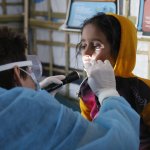
News • Asymptomatic disease spread
Why vaccines alone may not be enough to end the Covid-19 pandemic
Even as vaccines are becoming more readily available, protecting against the asymptomatic and pre-symptomatic spread of the virus (SARS-CoV-2) that causes Covid-19 is key to ending the pandemic, say two infectious disease experts at the Georgetown University Medical Center. In their Perspective, “SARS-CoV-2 Transmission Without Symptoms,” published in the journal Science, they make the case…


























